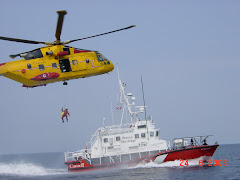In Jasper we were taught by the very knowledgeable guys who run Rescue Dynamics www.rescuedynamics.ca/ The lead instructor used to hold the world record for longest highline back in the day. During this two weeks we were instructed on high-angle rock rescue which consists of learning how to rig rescue systems for people you may be climbing with or as a rescuer who gets to the scene. I wasn't savvy in all the climbing/mountaineering stuff and was completely floored at what you can do with some rope and a little bit of gear. We did everything from simply pulling people up cliffs using simple 3:1 prusik-minding pulley systems to pulling teams of 4 up with a patient in a stokes litter with a 9:1 PMP system and even crevice rescue. We learned how to build various types of anchors from bolts, trees and rock using cams, stoppers, nuts, etc..

After that we got into actual rock climbing. This was the best part of the phase. From just basic rock climbing on belay to traditional lead climbing on multi-pitch routes. It was a blast and we were disappointed that it was only for 3 days. One thing I would like to comment on was the pace of the course and the amount of material covered. There is a lot of stuff to learn on this phase and I'm almost sure that without the coursemates we had that were already very educated in regards to climbing and mountaineering, the course as a whole would not have done as well as it did. *As a side note: This is a huge reason Course 42 was able to accomplish the learning objectives as easily as it did. We were lucky enough to have at least 2 guys versed in every aspect of the course which made it way easier for the rest to absorb the information.* The only reason we really have to learn how to rock climb is to use it as a method of insertion to get to a rescue scene.

After rock climbing it was on to snow and ice. Unfortunately we didn't do any ice climbing. That will be covered on our team leader course. This phase was geared towards learning how to self-arrest if you were sliding down a steep embankment, how to rig a rescue system using various anchors from snow and ice, and how to travel on snow and glaciers. The end of the portion and mountain ops culminated in the ascent of Mt. Athabasca, a 11,500 footer. After an early 0130 wake up to beat the sun and potential avalanche hazard we drove to the Columbia ice fields (about an hour south of Jasper) to begin our ascent. I found it to be quite an easy climb with some gorgeous scenery. Utilizing crampons for the majority of the climb along with our mountaineering axe we (very) slowly made our way up. It was a pretty uneventful 5 hour trip to the summit but we were awarded by a stunning view of the ice fields and the Rockies as far as the eye could see, along with the feeling of accomplishment you get at the top of a mountain.

Off to Ground Search and Final Ops in good ol' Jarvis Lake.



No comments:
Post a Comment